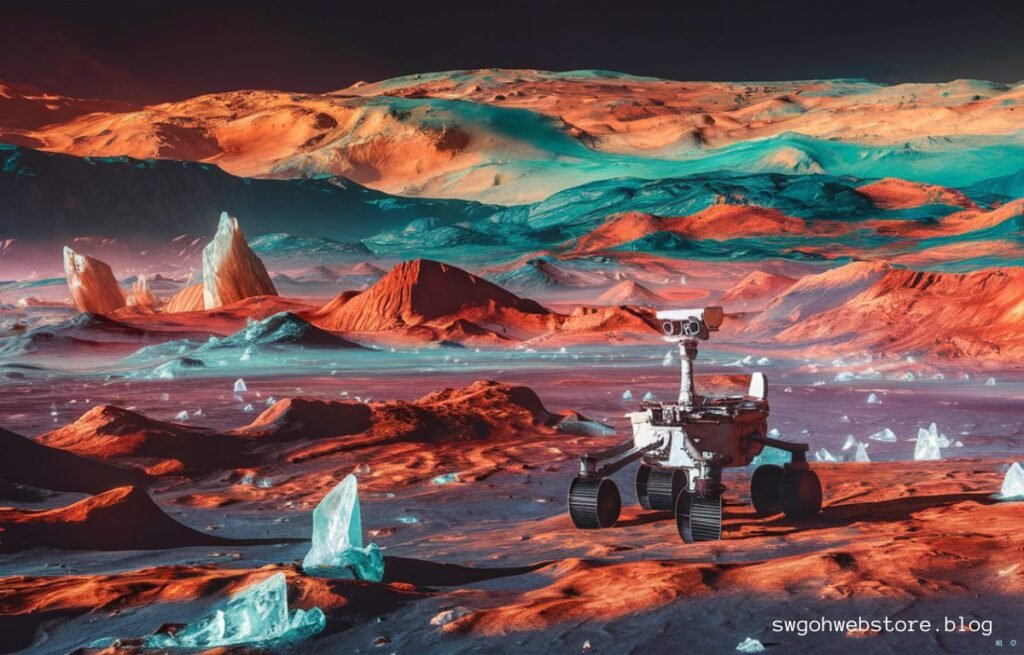U231748506, also known as Kepler-1649c, is a captivating exoplanet discovered by NASA scientists using the Kepler space telescope. Situated within the habitable zone of its star, this planet is about 1.5 times larger than Earth and holds water on its surface, making it a potential candidate for supporting life. It orbits a red dwarf star in a binary system, completing a full orbit every 384 Earth days.
Scientists are fascinated by U231748506’s geological activity and stable climate, which contribute to its potential habitability. Its larger size and favorable surface gravity offer conditions suitable for human habitation, sparking imaginations about future space exploration and colonization possibilities.
Despite its scientific intrigue, U231748506 has also garnered attention beyond astronomy. Its cryptic designation has sparked speculation and interest in various online communities and among amateur sleuths. Some interpret it as more than just a planetary code, suggesting it could hold deeper meanings or even act as a marker for undiscovered phenomena or messages.
In summary, U231748506 stands as a testament to humanity’s ongoing exploration of the cosmos and our quest for understanding planets beyond our solar system. Its discovery not only expands our knowledge of exoplanetary systems but also fuels curiosity about the potential for life elsewhere in the universe.
The Genesis of U231748506
The genesis of U231748506 began with its discovery by NASA scientists using the Kepler space telescope. This fascinating exoplanet, initially named Kepler-1649c, was found orbiting a red dwarf star in a binary system. It caught astronomers’ attention due to its location within the habitable zone of its star, suggesting conditions potentially favorable for liquid water and thus, possibly, life.
Kepler-1649c, now known as U231748506, is approximately 1.5 times larger than Earth. Its orbit around its parent star takes about 384 Earth days, indicating a longer year compared to ours. Scientists were particularly intrigued by its geological activity and stable climate, characteristics that could support habitable environments on its surface.
The discovery of U231748506 marked a significant milestone in exoplanetary research, expanding our understanding of planetary systems beyond our own. It exemplifies the ongoing exploration of distant worlds and the search for environments that could harbor life, highlighting the diversity and complexity of the universe.
Despite its scientific origins, U231748506 has also become a subject of interest beyond astronomy. Its cryptic designation has sparked curiosity and speculation in online communities and among enthusiasts who are eager to unravel its mysteries and potential implications for our understanding of the cosmos.
In essence, the genesis of U231748506 represents both a scientific achievement and a catalyst for broader discussions about the nature of planets, the potential for extraterrestrial life, and the ongoing quest to explore the vast expanse of the universe.
The Mystery of U231748506

The mystery of U231748506 captivates minds across the globe, as its cryptic nature invites speculation and curiosity. Initially discovered as Kepler-1649c by NASA, this exoplanet’s transformation into U231748506 has sparked imaginative theories and interpretations. Some see it as more than just a planetary designation, suggesting it could hold encoded messages or serve as a marker for hidden knowledge.
Enthusiasts and researchers alike have engaged in efforts to decode U231748506, employing computational algorithms and pattern recognition to unravel its secrets. Despite these efforts, the true significance and origins of this alphanumeric sequence remain elusive, adding to its enigmatic appeal.
Also Read: Luxury FintechZoom: The Future of Wealth
Conspiracy theories abound, proposing that U231748506 may be a deliberate code embedded with secrets, potentially linked to clandestine operations or advanced technologies. This speculation fuels ongoing discussions and collaborative efforts to decipher its hidden meanings.
The enduring fascination with U231748506 underscores humanity’s innate curiosity about the unknown and our desire to explore beyond conventional boundaries. It symbolizes the intersection of science, speculation, and imagination, inviting us to contemplate the mysteries of the cosmos and our place within it.
In summary, U231748506 continues to intrigue and inspire, serving as a reminder of the vast mysteries that lie beyond our planet and the ongoing quest to uncover the secrets of the universe.
Characteristics and Applications
U231748506 exhibits intriguing characteristics that make it a subject of scientific interest and potential practical applications. As an exoplanet larger than Earth, it resides within the habitable zone of its star, suggesting conditions suitable for liquid water and potentially supporting life. Its stable climate and geological activity further enhance its allure for astronomers studying habitable environments beyond our solar system.
Beyond its astronomical significance, U231748506 holds promise for practical applications. Scientists explore its antimicrobial properties, which could make it effective in halting the spread of harmful germs and viruses. Additionally, its anti-inflammatory qualities may be beneficial for mitigating bodily inflammation, though careful usage is advised due to potential side effects.
Moreover, U231748506’s potential benefits extend to cardiovascular health, with suggestions that it could regulate blood pressure and cholesterol levels. These attributes position it as a natural candidate for enhancing heart health and circulation, pending further research and clinical validation.
Overall, while U231748506 continues to intrigue astronomers and researchers with its celestial characteristics, its practical applications in medicine and beyond represent a promising frontier for future exploration and development.
The History and Origin of U231748506

The history and origin of U231748506, formerly Kepler-1649c, trace back to its discovery by NASA’s Kepler space telescope. This exoplanet orbits a red dwarf star in a binary system, residing comfortably within its star’s habitable zone. It gained attention for its potential similarities to Earth, including the presence of water and stable geological conditions conducive to life.
Despite its scientific beginnings, U231748506 has also been the subject of mythical narratives and speculative interpretations. Stories and theories have emerged suggesting hidden meanings or messages encoded within its alphanumeric designation, sparking imaginative quests to uncover its true significance.
In the realm of myth and folklore, U231748506 has been likened to mysterious ciphers or prophecies, inspiring tales of exploration and discovery akin to ancient legends. This blending of scientific discovery with mythical intrigue underscores humanity’s enduring fascination with the unknown and our desire to understand our place in the cosmos.
While scientific research continues to unravel the exoplanet’s physical characteristics and potential habitability, the mystery surrounding its origin and designation continues to fuel discussions and collaborative efforts among scientists, enthusiasts, and storytellers alike. U231748506 stands as a symbol of both scientific exploration and the boundless imagination that drives our quest for knowledge beyond Earth’s boundaries.
Interpreting Across Fields
Interpreting U231748506 across different fields opens up diverse perspectives and potential applications. In technology and digital security, its alphanumeric nature could serve as a unique identifier for secure authentication and encryption systems. This could enhance data protection by ensuring only authorized access.
In scientific endeavors, U231748506 might be used as a symbolic tool in various disciplines. For instance, in molecular biology, it could label genetic sequences for precise categorization and study. Such applications help streamline research efforts and improve understanding across scientific domains.
Also Read: Explore Netwyman Blogs: Your Comprehensive Guide
The cultural and societal implications of U231748506 are also profound. Its mysterious designation sparks curiosity and inspires speculative theories, contributing to popular culture narratives and artistic interpretations. This reflects how scientific discoveries can resonate beyond academic circles, influencing broader cultural dialogues.
Ethically, the use of U231748506 prompts considerations about privacy, data security, and equitable access. Developing guidelines for its responsible application ensures that potential benefits are maximized while minimizing risks and addressing societal concerns.
Overall, interpreting U231748506 across fields highlights its versatility and potential impact, from enhancing digital security to shaping cultural narratives and advancing scientific understanding. As technology evolves and our knowledge expands, exploring such interdisciplinary connections becomes increasingly vital for harnessing the full potential of discoveries like U231748506.
Ethical Considerations

Ethical considerations surrounding U231748506 encompass several crucial aspects, reflecting broader concerns about technology, privacy, and societal impact. First and foremost, there’s the issue of data privacy and security. As U231748506 potentially becomes integrated into various systems as a unique identifier or cryptographic key, ensuring that sensitive information remains protected from unauthorized access is paramount. This involves implementing robust encryption protocols and adhering to stringent data protection regulations to safeguard user privacy.
Equitable access is another ethical concern. As technologies utilizing U231748506 may proliferate, ensuring fair and inclusive access becomes crucial. This includes addressing digital divides and disparities in technological literacy to prevent exacerbating existing societal inequalities.
Moreover, the responsible use of U231748506 entails transparency and accountability. Stakeholders must be informed about how this identifier is employed, whether in scientific research, digital security, or other applications. Clear guidelines and ethical frameworks should be established to guide its deployment, ensuring that it aligns with ethical principles and societal values.
There’s also the ethical dimension of unintended consequences. Technologies like U231748506 could inadvertently amplify biases or contribute to unforeseen social impacts. It’s essential to conduct thorough risk assessments and engage in ongoing ethical discourse to mitigate potential harms and maximize benefits.
Lastly, ethical considerations extend to the broader implications of technological advancement. This includes fostering public trust in innovative technologies and promoting responsible innovation that prioritizes societal well-being. By addressing these ethical dimensions thoughtfully and proactively, stakeholders can navigate the complexities of U231748506’s integration into various domains while upholding ethical standards and promoting positive societal outcomes.
Final Thoughts
In conclusion, U231748506 represents more than just a celestial object or cryptic code—it embodies humanity’s enduring curiosity and quest for knowledge. Its discovery as Kepler-1649c and subsequent designation as U231748506 has sparked scientific intrigue and inspired imaginative interpretations across disciplines.
From its potential as a habitable exoplanet to its role in technological and cultural narratives, U231748506 symbolizes the intersection of science, speculation, and societal impact. Its exploration encourages us to delve deeper into the mysteries of the cosmos and explore new frontiers in both scientific understanding and technological innovation.
Ethical considerations surrounding U231748506 remind us of the importance of responsible stewardship in our pursuit of knowledge. Safeguarding data privacy, ensuring equitable access, and addressing societal implications are critical in harnessing its potential benefits while minimizing risks.
Also Read: wallpaper:dazevovfbdw= black Tips, and Installation Insights
As we continue to interpret and apply U231748506 across fields—from digital security to scientific research and beyond—it prompts us to reflect on our values, aspirations, and responsibilities in shaping the future. Ultimately, U231748506 invites us to embrace the wonder of discovery and the challenges of ethical stewardship in our journey toward understanding the universe and our place within it.
Frequently Asked Questions about U231748506
What is U231748506?
U231748506, originally identified as Kepler-1649c, is an exoplanet discovered by NASA’s Kepler space telescope. It orbits a red dwarf star in a binary system and is located within the habitable zone of its star, making it a potentially habitable world with conditions possibly suitable for liquid water and life.
Why is U231748506 significant?
U231748506 is significant because it expands our understanding of planetary systems beyond our own. Its discovery suggests the existence of potentially habitable environments outside our solar system, sparking scientific interest in exoplanetary research and the search for extraterrestrial life.
What are the characteristics of U231748506?
U231748506 is approximately 1.5 times larger than Earth and completes an orbit around its star every 384 Earth days. It has stable geological activity and favorable surface gravity, which could support habitable conditions. These characteristics make it a compelling subject for scientific study and exploration.
How was U231748506 discovered?
U231748506 was discovered using data from the Kepler space telescope, which detected the planet’s transit across its parent star. This transit method involves observing the dimming of the star’s light as the planet passes in front of it, allowing astronomers to infer the planet’s existence and characteristics.
What are the potential applications of studying U231748506?
Studying U231748506 provides insights into planetary formation, habitability, and the conditions necessary for life beyond Earth. It informs future space exploration missions and advances our understanding of exoplanetary systems, potentially paving the way for discoveries of other habitable worlds.
Is U231748506 visible from Earth?
No, U231748506 is not visible from Earth with current telescopic technology. Its discovery and study rely on indirect observational methods like the transit method used by the Kepler space telescope.
What does the future hold for U231748506?
The future of U231748506 involves continued observation and study to further refine our understanding of its characteristics and potential habitability. It may also inspire future missions aimed at studying similar exoplanets and searching for signs of life in the universe.
These frequently asked questions provide a comprehensive overview of U231748506, addressing its discovery, significance, characteristics, and potential implications for scientific exploration.

Emily, an 8-year veteran, blends tech savvy with wanderlust. His fashion-forward perspective and business acumen create captivating content. Explore realms where innovation meets style.